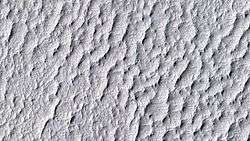Schiaparelli (Martian crater)
|
Elevation map of the Martian crater Schiaparelli, as seen by Mars Global Surveyor. | |
| Planet | Mars |
|---|---|
| Coordinates | 2°42′S 16°42′E / 2.7°S 16.7°ECoordinates: 2°42′S 16°42′E / 2.7°S 16.7°E |
| Diameter | 461 km |
| Eponym | Giovanni Schiaparelli |
Schiaparelli is an impact crater on Mars named after Giovanni Schiaparelli located near Mars's equator. It is 461 kilometers (286 mi) in diameter and located at latitude 3° south and longitude 344°. A crater within Schiaparelli shows many layers that may have formed by the wind, volcanoes, or deposition under water.
Layers can be a few meters thick or tens of meters thick. Recent research on these layers suggests that ancient climate change on Mars, caused by regular variation in the planet's tilt, may have caused the patterns in layers. On Earth, similar changes (astronomical forcing) of climate results in ice-age cycles.
The regular appearance of rock layers suggests that regular changes in climate may be the root cause. Regular changes in climate may be due to variations of a planet's tilt (called obliquity). The tilt of the Earth's axis changes by only a little more than 2 degrees since our moon is relatively large. In contrast Mars's tilt varies by tens of degrees. When the tilt is low (current situation on Mars), the poles are the coldest places on the planet, while the equator is the warmest (as on Earth). This could cause gases in the atmosphere, like water and carbon dioxide, to migrate poleward, where they would freeze. When the obliquity is higher, the poles receive more sunlight, causing those materials to migrate away. When carbon dioxide moves from the Martian poles, the atmospheric pressure increases, possibly causing a difference in the ability of winds to transport and deposit sand. Also, with more water in the atmosphere sand grains may stick and cement together to form layers.[1]
In popular culture
In the novel The Martian by Andy Weir, Schiaparelli is the landing site for Ares 4, the fourth manned mission to Mars. The protagonist, an astronaut from Ares 3 who is stranded on Mars, must travel from Acidalia Planitia to Schiaparelli, a journey of 3,200 kilometres (2,000 mi).[2]
 Layers in a crater in the Schiaparelli basin as seen by MGS.
Layers in a crater in the Schiaparelli basin as seen by MGS.- Layers in Crater within Schiaparelli crater, as seen by HiRISE. Image from Sinus Sabaeus quadrangle.
 Layers in Monument Valley. These are accepted as being formed, at least in part, by water deposition. Since Mars contains similar layers, water remains as a major cause of layering on Mars.
Layers in Monument Valley. These are accepted as being formed, at least in part, by water deposition. Since Mars contains similar layers, water remains as a major cause of layering on Mars. Circular structures on floor of Schiaparelli crater, as seen by HiRISE under HiWish program.
Circular structures on floor of Schiaparelli crater, as seen by HiRISE under HiWish program. Close-up of circular structure from previous image. Streaks are also visible.
Close-up of circular structure from previous image. Streaks are also visible. Impact crater located near the equator in north-western Schiaparelli Basin.
Impact crater located near the equator in north-western Schiaparelli Basin.
The Martian (2015 film)
Ares IV Mission - Landing Site
(SW corner of Schiaparella crater).
 Wide view of layers in Schiaparelli Crater, as seen by HiRISE under HiWish program Part of the picture is degraded. Parts of this image are enlarged in other images that follow.
Wide view of layers in Schiaparelli Crater, as seen by HiRISE under HiWish program Part of the picture is degraded. Parts of this image are enlarged in other images that follow. Layered mound in Schiaparelli Crater, as seen by HiRISE under HiWish program
Layered mound in Schiaparelli Crater, as seen by HiRISE under HiWish program Layers in Schiaparelli Crater, as seen by HiRISE under HiWish program
Layers in Schiaparelli Crater, as seen by HiRISE under HiWish program Layered mound in Schiaparelli Crater, as seen by HiRISE under HiWish program
Layered mound in Schiaparelli Crater, as seen by HiRISE under HiWish program Layers in Schiaparelli Crater, as seen by HiRISE under HiWish program
Layers in Schiaparelli Crater, as seen by HiRISE under HiWish program Layers in Schiaparelli Crater, as seen by HiRISE under HiWish program
Layers in Schiaparelli Crater, as seen by HiRISE under HiWish program Layers in Schiaparelli Crater, as seen by HiRISE under HiWish program
Layers in Schiaparelli Crater, as seen by HiRISE under HiWish program Close view of layers in Schiaparelli Crater, as seen by HiRISE under HiWish program Dark sand is visible on some layers.
Close view of layers in Schiaparelli Crater, as seen by HiRISE under HiWish program Dark sand is visible on some layers. Close, color view of layers in Schiaparelli Crater, as seen by HiRISE under HiWish program Dark sand is visible on some layers.
Close, color view of layers in Schiaparelli Crater, as seen by HiRISE under HiWish program Dark sand is visible on some layers.
Location on Mars

References
| Wikimedia Commons has media related to Schiaparelli (Martian crater). |
- ↑ http://www.spaceref.com:80/news/viewpr.html.pid=27101
- ↑ Weir, Andy (2014). The Martian. New York: Crown Publishers. ISBN 978-0-8041-3902-1.
External links
- Layers, Bedrock Ridges, and Dark Sand in Schiaparelli Crater, LPL HiRISE, includes large color photos
